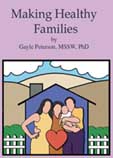EXERCISE:
What Are Your Family Blueprints
created by Gayle
Peterson, including
Excerpts from Making
Healthy Families

In order to explore where your family of origin was
on the continuum, take 30 minutes to explore the past with your partner.
If you are a single parent, answer these questions for yourself, or
if you wish, do this exercise with a friend or relative with whom
you feel safe. Keep in mind that you may have experienced these areas
differently than your siblings, or differently at one time in your
childhood, than another. Use the age of 12 as a reference point in
time for answering these questions about your experience of your family-of-origin
(unless otherwise stated, or you have a strong preference to use another
point in time)
1. What was the quality of your parents’ relationship?
Was love expressed in words? Was anger expressed verbally in your
family and between your parents? Was the expression of anger “safe”
in your family and in your parents’ relationship, or emotionally
“threatening”? Was the expression of love openly shared
or repressed?
This dimension refers to the relationship between
love and anger. Being able to express anger without attacking character
or violating safety, coupled with the ability to express caring openly
creates a range of expression in the family that encourages connection
over disconnection.
Rate from 1-10, with 1 representing that in the family
atmosphere only positive (loving) feelings were comfortable being
expressed and 10 being only negative (angry) feelings were commonly
expressed. 5 would represent an equal ability to express anger
without denying love.
1--2--3--4--5--6--7--8--9--10
2. How did your parents’ resolve conflict with
one another? How was conflict resolved in your family in general?
Rate from 1-10 with 1 representing that conflict was
never overtly expressed, and so left unresolved and 10 representing
that conflict was repeatedly expressed in anger and disrespect, but
without mutual resolution. A family atmosphere which allows for expression
without discounting or denigration promotes healthy negotiation. 5
would represent an atmosphere in which differences could be
expressed and explored without attacking character, and mutually acceptable
solutions would be found.
1--2--3--4--5--6--7--8--9--10
3. Was communication open, direct and clear? Or was
it ambiguous, nonverbal, coercive?
Rate from 1-10 with 1 representing pressure to mind-read
people’s needs (saying “yes” when they really mean
“no”) to 10 representing repeated and consistent misinterpretations/accusations
of others’ behavior. (“If you loved me you would have------”).
A family atmosphere in which a full range of emotions
is acceptable allows members to release tensions and frustrations
without damaging relationships. Feelings do not necessarily require
action, and so understanding between people is more likely. Discussions
can develop and be sustained which encourages connection over disconnection.
5 would represent non-blaming clarification of feelings and differing
points of view, and safety in the family system for anything to be
discussed. There would be room for feelings to be expressed and explored.
Feelings are not seen as actions, and so can be validated as such.
1--2--3--4--5--6--7--8--9--10
4. What was your family’s relationship to the
outside community as you grew up? What was your relationship to your
parents and to the outside community as you grew up? Where did you
go for help as a youngster, a teenager?
Rate from 1-10 with 1 representing complete dependence
on family to answer all needs to 10 representing complete dependence
on others outside the family for help, guidance and nurturing. Families
benefit from outside support which promotes feelings of connection
inside the family. 5 would represent a balance of both, changing appropriately
with age.
1--2--3--4--5--6--7--8--9--10
5. Did your parents support your growing independence
from the family as a child, an adolescent, a young adult?
Rate from 1-10 with 1 representing much difficulty
and feeling pressure not to develop your own interests and ideas in
adolescence, to 10 representing being “on your own” as
a teenager with little guidance. Reflect also on how you did leave
home. Were you adequately supported to develop your own independence?
A family atmosphere of emotional commitment to fulfill
the changing needs and to act in the best interests of their children
promotes connection between family members over a lifetime. 5 would
represent feeling supported to develop your own interests as an adolescent
and to leave home as a young adult, but with emotional support from
your family as you established your place in the world.
1--2--3--4--5--6--7--8--9--10
Get a sense of where your childhood experience put
you on the spectrum, (1 is rigidly centripetal, 10 rigidly centrifugal,etc.).
Many times, you will find that your family culture tended towards
one end, and your partner’s towards the other. By learning this,
you can consciously choose to adopt new guidelines that solicit your
strengths, and correct for your weaknesses. Or you will discover one
area (resolving conflict, expression of feelings) that tends towards
the extreme.
After discussing and exploring your own family blueprints,
do the following worksheet to develop your awareness of your vision
for your present family relationships. Be conscious of childhood patterns
and how they may be influencing your present family processes. Our
parents are our first role models. Our job as parents is to sort through
our past, taking what we want to continue in our own families, and
letting go of that which we do not want to repeat.
 Go
to: Worksheet: What Is Your Family Atmostphere? Go
to: Worksheet: What Is Your Family Atmostphere?
|